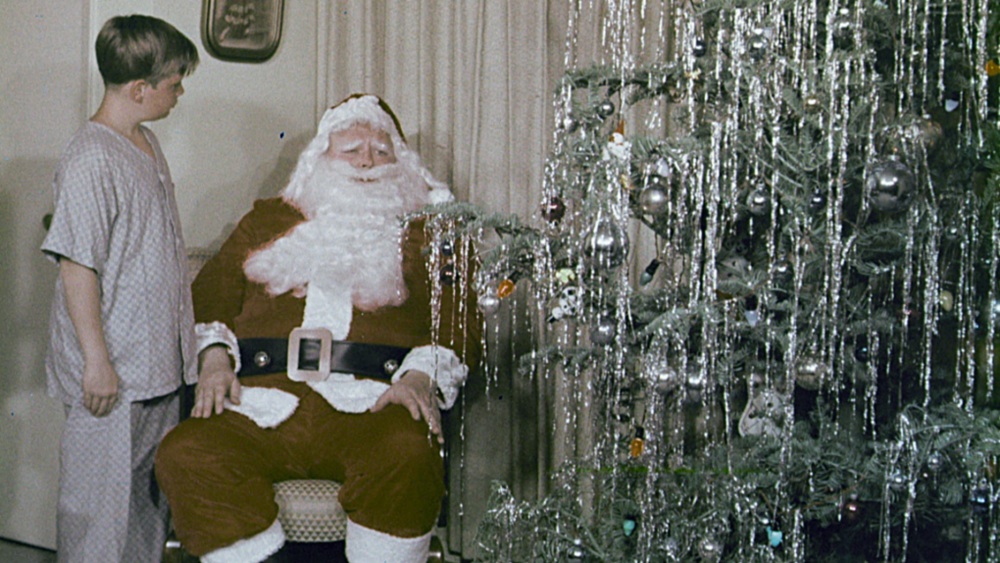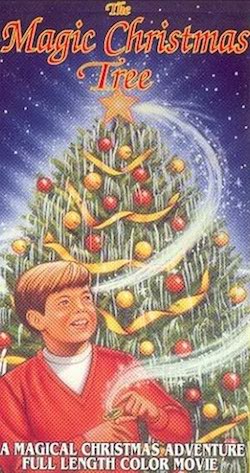
The Magic Christmas Tree (USA, 1964) 59 min color-B&W DIR: Richard C. Parish. PROD: Fred C. Gerrior. SCR: Harold Vaughn Taylor. CAST: Chris Kroesen, Valerie Hobbs, Robert “Big Buck” Maffei, Darlene Lohnes, Howard Blevins.

During Halloween season, little boy Mark (Chris Kroesen) helps a witch (Valerie Hobbs) get her cat Lucifer down from a tree, and for his kindness, he is rewarded with a (talking) Magic Christmas Tree that grants him three wishes. Mark’s first wish is to give himself power over everything for an hour, thereby turning night into day, and creating merry mayhem by allowing vehicles to run away on their owners. His second wish is the selfish notion to have Santa Claus (Howard Blevins) all to himself. Will his third wish be of any virtue?
This jaw-dropping holiday film (although clocking in at less than an hour, feels twice as long), begins in black-and-white, likely inspired by The Wizard of Oz, and yet feels like a failed 60s suburban “Our Gang” reboot, replete with “ah gee golly whiz” dialog indicative of Spanky and the bunch, as Mark and his friends gripe over what each has brought to school for lunch. Once the tree appears, the film bursts into powdery full colour, resembling a Sid Davis film run amuck, with a sterile look befitting the middle class suburban milieu. The stifling, locked-off camera work, the rubbery post-sync sound and the wooden performances make this like a classroom film from Hell.
To adult eyes, this deceptively short film may be interminable with its stock footage, unimaginative mise en scene, sloppy production values (look closely for the crouching stunt bodies at the wheel of the so-called driver-less cars), and its uninspired slapstick (the father attempts to chop down the title tree for what seems like minutes). On the other hand, older viewers would notice the sarcastic tone that would escape its target kiddie matinee audience. This bitter poem about greed has a novel character in a talking tree, whose voice (resembling an effeminate version of a world-weary Jack Benny) hardly sounds inviting. In the sequence detailing the “second wish”, Mark is held captive by a forest giant who allows the lad to be as greedy as he wants provided that he remains the big man’s slave. In a perverse spin on A Christmas Carol, he is forced to gaze into a pool of water to see the aftermath of his selfish request. Via representative footage and a droning narrative, Mark is witness to how the world is in turmoil due to the missing Santa Claus held captive in his living room next to a caustic Christmas tree! (Explain this one to the missus.) The giant agrees to let Mark back to the real world on the condition that he undoes his greedy actions. And to hammer home the point once again, the giant points to the camera, warning the kiddie audience that the next greedy kid to be his prisoner “could be you!” Like the primitive educational scare films of Sid Davis, this movie sends its characters on a one-way ticket to Hell, and additionally refuses to let its viewers off the hook.
The Magic Christmas Tree is pedestrian on both sides of the camera, while fascinating for all the wrong reasons. It was likely marketed as wholesome family fare (and apparently was re-issued several times for the matinee circuit over the years), which however bites the little hands that reached up to the ticket booth. On the whole, the movie feels like the work of cynical adults having the last laugh on the kiddie market, even if the cynical undertones would go unnoticed by its target audience. This was released to VHS by Jeffrey C. Hogue, who had acquired several oddball regionally-produced curios for home video.
